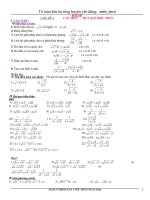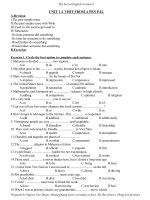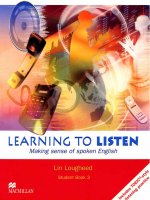- Trang chủ >>
- Đề thi >>
- Đề thi lớp 6
9 Tips to Get Your Young Learners to Listen st
Bạn đang xem bản rút gọn của tài liệu. Xem và tải ngay bản đầy đủ của tài liệu tại đây (286.71 KB, 6 trang )
<span class='text_page_counter'>(1)</span>Any teacher who has taught young learners can tell you, it’s sometimes hard to get them to listen. I’m not just talking about getting them to listen to you as you give them instructions, but also listen so they can hone their listening skills – real, focused, targeted listening, not just the passive listen-to-get-by kind. If you want to motivate your young learners to listen, these tips might help.. 9 Tips to Get Your Young Learners to Listen. 1. 1 Think Active, not Passive Don’t mistake receptive for passive. Listening is receptive in the sense that students receive input in the form ofaudio (contrary to speaking or writing which is productive), but students should still be active in their listening and actively engaged. For ways to keep young learners actively engaged, keep reading.. 2.2 Choose Engaging Listening Tasks.
<span class='text_page_counter'>(2)</span> The types of listening tasks you’ll give your young learners are very different from what you’d give adult learners. Adult learners often listen to dialogues and answer comprehension questions. Although you may try to do this with young learners, they will seldom be engaged by listening to conversations. So what types of listening tasks engage young learners?. o o. First, they must be age appropriate. Second, what do children love? Songs, stories and videos.. 3.3 Do Several Listenings with Different Types of Tasks Whether you choose a song or story to have them listen to, or a video to watch, have them listen to it several times and give them a different type of activity each time. For example, you decide to play the audio for or read a short story. The first listening should help them grasp the general idea of the story, who the characters are and what they do. Next, they should listen again and do a gap-filling exercise. Finally, they should listen one last time and complete one more activity, which may be a drawing based on the story or a writing assignment if they’re old enough.. 4.4.
<span class='text_page_counter'>(3)</span> Consider all the Types of Activities They Can Do Young learners can do several things with a listening exercise:. o. They can listen and produce something based on what they heard, such as a drawing, a clay model or any type of craft.. o o. They can listen and repeat or mime. They can listen and predict what will happen next.. o. They can listen and reply, as in a conversation where they hear only one. o o. side and respond to what the speaker says. They can listen and write a story or summary about what they heard. They can listen and match, fill in gaps or complete any type of. o. worksheet based on the listening. They can listen to a story as model for pronunciation and then read the story themselves. And you thought there was very little they could do!. 5.5 Be a Model! Remember that you don’t necessarily have to play an audio file in MP3, CD or video for effective listening practice. You can read.
<span class='text_page_counter'>(4)</span> something out loud, too! The importance lies not in the format of the audio, but rather in the content – make sure it’s an engaging story or activity, and they’ll be hooked!. 6.6 Make It Familiar Young learners can be great little listeners, but they need to listen to things they are familiar with, or they’ll tune out. Children are typically familiar with things that other kids and families do. They may be interested in what kids in other countries do but be careful with the accents. If they’ve been largely exposed to an American English accent, they may not understand a kid from Northern Ireland talking about a typical festivity or holiday. They may not understand accents from other regions.. 7.7 Introduce New Vocabulary With older children, you may want to open a window to the rest of the world, and show them things they wouldn’t ordinarily see. But.
<span class='text_page_counter'>(5)</span> make sure you introduce new vocabulary and explain the context, whether it is a local tradition or festivity, before you actually play the video.. 8.8 Always Include Listening While it’s great to plan activities that are specific for listening practice, try to include listening in most of the things you do, like games, for example. When students are engaged in the activity you set forth, you can bet they will prick up their ears and listen to every word you say.. 9.9 Choose Songs Carefully Children love to listen to and sing songs. But the latest Lady Gaga tune may not the best song for our goal. What is our goal? Let’s consider first what it is not. It is not to teach them how to sing the songs they like. Our goal is to use songs to help teach the language and help them improve listening skills. So with this in mind, choose songs that are easy to understand and contain language students are familiar with. It is also.
<span class='text_page_counter'>(6)</span> helpful if songs are related to something you have taught, whether it is vocabulary or grammar. For instance, after a lesson aboutanimals, the logical choice for a song is Old McDonald. Finally, songs with lines that repeat or those that have actions students can do are also great choices. To be able to boost students’ listening, you first have to get them to listen. Get them engaged in the listening task, and they won’t tune out.. If you have any tips to add, share them in the comments below!.
<span class='text_page_counter'>(7)</span>









